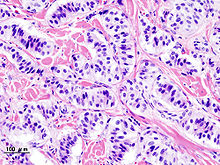Insulinoma
| Classification according to ICD-10 | |
|---|---|
| D13.7 | Benign neoplasm: endocrine glandular portion of the pancreas |
| C25.4 | Malignant neoplasm: endocrine glandular portion of the pancreas |
| ICD-10 online (WHO version 2019) | |
The insulinoma is a rare, mostly benign neuroendocrine tumor from endocrine cells ( islets of Langerhans ) in the pancreas , in which more insulin is produced and which is noticeable through recurrent hypoglycaemia . Usually it is an adenoma . Approx. 50% of insulinomas produce other gastrointestinal hormones in addition to insulin.
Occurrence
The insulinoma is the most common hormone-active tumor of the pancreas with an overproduction of insulin or proinsulin .
The tumor, which is benign in 90%, occurs about twice as often in women as in men. The incidence is 2–4: 1,000,000 per year. The maximum age is around 50 years. However, any age can be affected.
Veterinary medicine
Insulinomas are the most common tumors in ferrets . There they occur at a frequency of 10 to 20%.
pathology
Histologically, it is an insulin-producing neuroendocrine neoplasia of the B cells of the islets of Langerhans in the pancreas in the form of islet cell adenoma. Adenocarcinoma is present in around 10% of cases , and liver metastases can then usually be detected.
Symptoms
Hypoglycaemia occurs repeatedly, which manifests itself in food cravings, impaired consciousness, dizziness , seizures , sweats and weight gain (due to the food cravings). If left untreated, the recurrent hypoglycaemia can lead to CNS damage.
The Whipple triad is typical :
- Evidence of hypoglycaemia (blood sugar <45 mg / dl; <2.5 mmol / l)
- Simultaneous presence of hypoglycaemia
- Rapid elimination of symptoms after carbohydrate intake
Diagnosis
- Blood glucose tests
- repeatedly decreased blood sugar values by 40 mg / dl (= 2.2 mmol / l)
- especially after prolonged fasting or physical exertion
- extended oral glucose tolerance test and subsequent 72h hunger test with regular blood sugar measurements
- increased insulin production
- the insulin concentration in the blood is too high relative to the blood sugar level due to unchecked insulin release
- Due to the increased insulin production, the C-peptide, which can be detected in the serum, is also increased
- Ultrasound of the pancreas
- Contrast medium ultrasound of the pancreas: as a neuroendocrine tumor, the insulinoma is usually strongly perfused and increasingly enriches contrast enhancers in the early arterial phase.
- Endoscopic ultrasound : current gold standard
- CT of the pancreas
- Magnetic resonance imaging of the pancreas
- PET / CT when using the tracer F -18- DOPA .
- Exendin-4 SPECT / CT: When this relatively new procedure is the so-called "glucagon-like peptide-1 receptor" (GLP-1 receptor) with the aid of radioactive indium ( 111 home DTPA labeled -exendin-4). In a recent study, 95 percent of insulinomas could be localized with this method.
- Intraarterial calcium stimulation test : In this test, calcium gluconate is gradually under an angiography in the pancreas supplying vessels ( gastroduodenal artery , superior mesenteric artery and artery splenic ) was injected and after 30, 60 and 120 seconds, a blood sampling from the right hepatic vein carried out and from this the insulin levels determined . An insulinoma can be proven by an increase in the insulin in the liver vein blood over twice the basic insulin value. At the same time, this test can be used to narrow down the coverage area of the insulinoma. During a pancreas resection, this supports the surgeon's palpation findings in addition to intraoperative sonography.
Differential diagnosis
- The hypoglycaemia factitia , the intentional causing of low blood sugar, is an important differential diagnosis in all hypoglycemia is that diabetics not occur in diabetics and.
- Hypoglycaemia can occur as part of the therapy of diabetes mellitus with drugs that lower blood sugar .
therapy
The treatment of choice is surgical removal of the tumor; beforehand, drug-based inhibition of insulin secretion can be attempted with diazoxide or lanreotide / octreotide . Cytostatic treatment with streptozotocin is also an option .
Web links
- Histology on PathoPic
- Macroscopic image on PathoPic
- Information on insulinoma
- Sonographic case report of an insulinoma
Individual evidence
- ↑ Insulinoma (teaching text from the University of Heidelberg)
- ↑ medizin.uni-koeln.de Institute for Clinical Chemistry at the University Hospital Cologne - last update: April 28, 2010.
- ↑ Fluorine-18-L-Dihydroxyphenylalanine (18F-DOPA) Positron Emission Tomography as a Tool to Localize an Insulinoma or β-Cell Hyperplasia in Adult Patients
- ↑ Glucagon-like Peptide 1 - Receptor Scans to Localize Occult Insulinomas. In: N Engl J Med. 2008; 359, pp. 766-768, August 14, 2008, doi: 10.1056 / NEJMc0802045
- ↑ Glucagon-Like Peptide-1 Receptor Imaging for Localization of Insulinomas
- ↑ A. Sowa-Staszczak include: glucagon-like peptide-1 receptor imaging with [Lys40 (Ahx-HYNIC- 99m / EDDA) NH 2] -exendin-4 for the detection of insulinoma. In: European journal of nuclear medicine and molecular imaging. Volume 40, Number 4, April 2013, pp. 524-531, ISSN 1619-7089 . doi: 10.1007 / s00259-012-2299-1 . PMID 23224740 . PMC 3590421 (free full text).
- ↑ Glucagon-like peptide-1 receptor imaging for the localization of insulinomas: a prospective multicenter imaging study. In: The Lancet Diabetes & Endocrinology. Volume 1, Issue 2, pp. 115-122, October 2013.
- ↑ Pancreas: New method recognizes tumors better , PSI communication of July 29, 2013.
- ↑ PL Pereira et al. Insulinoma and islet cell hyperplasia: value of the calcium intraarterial stimulation test when findings of other preoperative studies are negative. ( Page no longer available , search in web archives ) Info: The link was automatically marked as defective. Please check the link according to the instructions and then remove this notice. In: Radiology March. 1998, 206, pp. 703-709.
